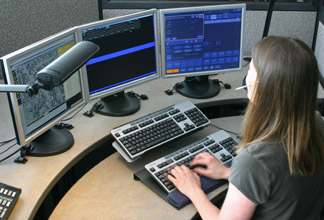What to do when you call 9-1-1
 When calling 9-1-1, all you have to do is answer the operator’s questions!
When calling 9-1-1, all you have to do is answer the operator’s questions!
- Stay calm.
- Speak clearly.
- State the problem you are reporting
- Be prepared to answer the following:
- Location of the problem – full address and nearest cross street
- Your name
- Phone number you are calling from
- Stay on the phone until either the 9-1-1 dispatcher or the on-scene police or fire personnel direct you to hang up.
When You Call 9-1-1
The call taker must ask many questions so they can give deputies an accurate picture of your situation.
- If a deputy is to respond, the operator enters the information into a Computer Aided Dispatch (CAD) system, and it is electronically routed to the proper dispatcher. They will send a deputy to the scene.
- Emergency response is not delayed while you answer the questions. In fact, deputies are usually already on the way while you are on the phone.
- As you answer the operator's questions, the dispatcher can relay important information to the units responding prior to their arrival.
- Sometimes it may sound as if we are asking the same questions. Please don't become frustrated. We are trying to help, and people often provide details that help police when questions are repeated.
The Questions they May Ask
The call taker needs to ask the basic 4W’s for every call: Where, what, when, and who.
- Where: Where are you and where did the incident happen?
- This is important in case the phone is disconnected for some reason. Even though the 9-1-1 screen in dispatch should have the phone number and address of the phone you are calling from, the dispatcher will ask you the address where the problem is, as well as where you are calling from, to verify the information on the 9-1-1 screen. You may be calling from an address other than the one where the problem is.
- It is important to give any building names, building numbers, apartment or condominium names and unit or suite number.
- Be as specific as possible. Avoid using "left" and "right" as directions. This is often confusing. Instead use a direction such as "North" or "South". The best locations are specific street address or cross streets.
- What: What is the nature of the problem?
- Please use real language – don’t try to use lingo or slang, it will only confuse the situation. Just tell us briefly what is happening or what happened.
a. Is anyone injured?
b. Basic description of what occurred.
- Please use real language – don’t try to use lingo or slang, it will only confuse the situation. Just tell us briefly what is happening or what happened.
- When: When did this occur?
- 5 minutes ago, 5 days ago, last year, over time
- Who: Who or what is involved?
- How many people are involved?
- Race, sex, height, weight, clothing, hair color, facial hair, eyeglasses, hat, etc.
- DID THE PERSON HAVE A WEAPON? If so what kind
- Was the person carrying anything?
- Where did the person go?
- You also may be asked about the vehicle -- color, make, model, license #, and # of doors, and direction of travel
Reports by Phone
If the call can be handled without deputy response, or is a report to be taken at the center, the caller is routed to a secondary or non-emergency operator. Routing some calls to non-emergency operators makes it possible for us to respond quickly to emergencies.
Interpretive Services
Interpreter services are available for 9-1-1 calls. Simply call 9-1-1 and state the language you require.

 Translate
Translate